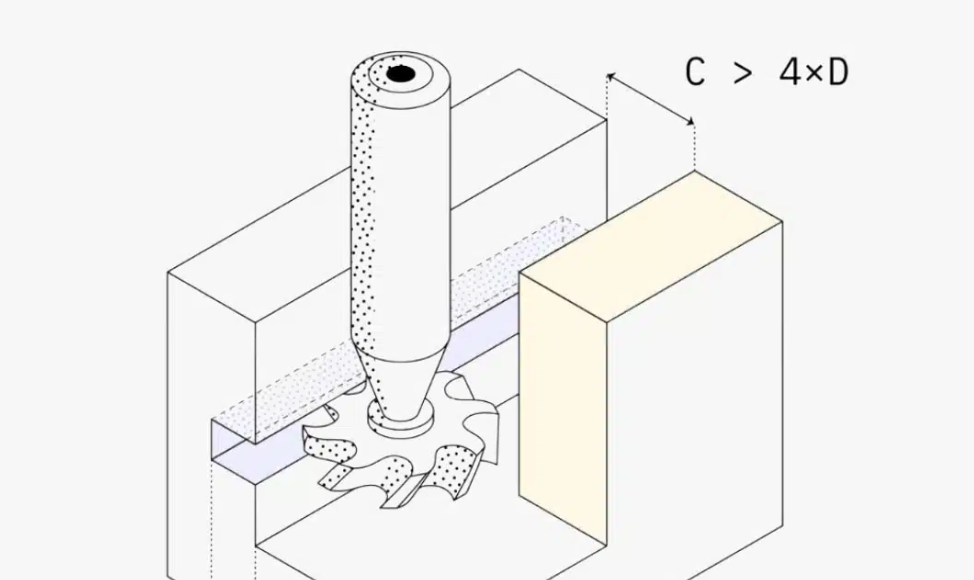Undercut machining is a critical technique used in various manufacturing processes where material is removed in a manner that creates a feature or cavity under an overhanging or obstructing part of the workpiece. It allows for the creation of intricate geometries that would be impossible with conventional machining methods. This article will explore the basics of Undercut Machining, its techniques, applications, and considerations that manufacturers should keep in mind when utilizing this method.
What is Undercut Machining?
In machining, an undercut refers to a section of a workpiece that is cut underneath an overhanging area or an existing feature, typically at an angle. Unlike standard cuts that only remove material from the top or surface, undercut machining involves cutting the material from the sides or the bottom, often creating geometries that are difficult to achieve through standard milling or turning operations.
Undercutting is commonly used in industries such as aerospace, automotive, medical devices, and mold-making, where complex features are required. It involves cutting tools that can reach areas that would otherwise be obstructed or inaccessible.
Key Techniques in Undercut Machining
1. Ball Nose End Mills
Ball nose end mills are one of the most commonly used tools for undercut machining. They have a rounded edge, which allows for smooth cutting in three-dimensional surfaces. When performing an undercut operation, these mills are often used to create slots, pockets, and curved geometries beneath an overhanging surface. Their versatility makes them ideal for machining complex contours and undercuts in both roughing and finishing operations.
2. 5-Axis CNC Machining
5-axis CNC (Computer Numerical Control) machining is another crucial technique in Undercut Machining. With the ability to move the tool along five different axes, this system can reach virtually any part of a workpiece, including areas that are obstructed. The added rotational axes enable the cutting tool to access difficult-to-reach undercuts, which would be nearly impossible with traditional 3-axis milling.
5-axis machines provide greater flexibility and precision, allowing for the creation of highly complex parts with undercut features without the need for multiple setups.
3. Wire EDM (Electrical Discharge Machining)
Wire EDM is another popular method for creating undercuts, especially in hard metals and intricate designs. A thin wire, often made of brass or copper, is passed through the workpiece while an electrical discharge removes material. Wire EDM can easily navigate undercuts that may be difficult for traditional tools, as it uses no physical contact between the tool and the workpiece, allowing for highly precise cuts in any direction.
Wire EDM is especially beneficial when machining components with intricate shapes, such as those found in mold making, aerospace, and tooling applications.
4. Indexable Tooling
In certain cases, indexable tooling is used to machine undercuts, especially when higher feed rates or quicker removal of material is necessary. These tools have a replaceable insert and are frequently used in turning or milling operations to create undercuts in cylindrical parts or components that require continuous cutting action.
5. Milling with Specialized Tools
Other milling tools, such as dovetail cutters or angle cutters, can also be utilized to create undercut features. These tools are typically used in situations where undercuts are required along specific angles, such as in the automotive or aerospace industries for making parts like gearboxes or engine components.
Applications of Undercut Machining
Undercut machining plays an important role in a wide range of applications where precision and intricate designs are crucial. Some of the primary industries where undercut machining is commonly used include:
1. Aerospace Industry
The aerospace industry requires extremely complex parts, such as engine components, turbine blades, and brackets, that often include undercuts for lightweight yet strong structures. These components need to meet stringent safety, weight, and performance criteria, making undercut machining essential for creating precise, optimized parts.
2. Automotive Industry
In automotive manufacturing, undercut machining is commonly used for creating parts like engine blocks, pistons, transmission components, and suspension systems. The automotive industry often demands parts with intricate geometries, where undercuts can help reduce weight, improve aerodynamics, and enhance overall performance.
3. Medical Device Manufacturing
Medical devices, such as surgical instruments and implants, require high levels of accuracy, and Undercut Machining is often used to create small, complex features. For instance, bone screws, joint replacements, and dental tools are often machined with undercuts to ensure proper fit, function, and structural integrity.
4. Mold and Die Making
Mold and die making involves crafting tools that create parts for injection molding, casting, or forging. Undercut machining is used to shape the mold cavities that form the parts. Since molds often need to release the formed parts easily, creating undercuts or negative features in the mold allows for a more efficient removal of the part after it cools.
5. Consumer Electronics
Undercuts are also found in consumer electronics such as housings, enclosures, and connectors, where precision and compact design are crucial. The manufacturing of these components requires a high level of expertise to create parts that both fit together seamlessly and maintain their strength and durability.
Benefits of Undercut Machining
Undercut machining offers several benefits that are essential for producing high-quality, complex components:
1. Design Flexibility
Undercut machining allows for the creation of geometries that would otherwise be impossible using traditional methods. It provides designers with the flexibility to produce highly complex parts without compromising on material properties or performance.
2. Material Efficiency
By enabling the removal of material in intricate patterns and shapes, undercut machining helps to reduce the overall material waste. This is particularly important in industries where material costs are high, and waste reduction is crucial for maintaining profitability.
3. Improved Component Performance
Undercut features can enhance the performance of a part by improving its weight distribution, reducing stress concentrations, and optimizing overall functionality. For example, aerospace components benefit from undercuts to reduce weight while maintaining structural integrity.
4. Enhanced Surface Finish
Using techniques such as 5-axis CNC machining and wire EDM, undercut machining often results in superior surface finishes. These high-quality finishes are essential for many industries where the aesthetics and functionality of the part matter.
Considerations in Undercut Machining
While undercut machining offers many advantages, there are some important considerations to keep in mind during the process:
1. Tool Access
The ability to access all required areas of the workpiece is one of the primary challenges in undercut machining. Not all machines or cutting tools can reach undercut areas, so selecting the right tool and machining strategy is essential for achieving the desired result.
2. Tool Wear
Undercutting can place significant stress on cutting tools, leading to faster wear. Tool life management is important, and operators need to monitor cutting parameters closely to avoid excessive wear and to maintain the precision of the part.
3. Complex Setup
Undercut machining often requires more complex setups than conventional machining, particularly when multiple tool changes or complex tool paths are involved. The increased setup time can result in higher costs, especially when using 5-axis machines or specialized tooling.
4. Surface Integrity
As with any machining operation, ensuring the proper surface integrity after the undercut machining process is crucial. Care must be taken to avoid issues like burr formation, tool marks, or surface distortion, which can affect the part’s overall quality.
Conclusion
Undercut machining is a vital process in modern manufacturing, enabling the creation of complex and high-performance components. It is used across numerous industries, including aerospace, automotive, medical device manufacturing, and mold-making. By using advanced techniques such as 5-axis CNC machining, ball nose end mills, and wire EDM, manufacturers can achieve the precision and design flexibility necessary for creating parts with intricate geometries. While there are challenges, such as tool access and wear, the benefits of Undercut Machining, including material efficiency, design flexibility, and improved performance, make it a valuable technique for creating innovative and high-quality products.










